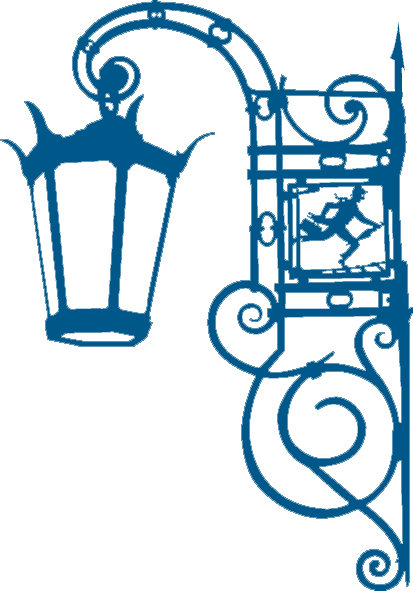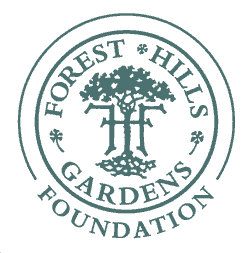
Founded in 1992 for the preservation, improvement and beautification of Station Square, Forest Hills and its surrounds.

THE HISTORY
BACKGROUND
In 1910 Forest Hills was a small village surrounded by thriving farms. Only ten miles from the commercial district of Manhattan, its farms supplied fruits, vegetables and dairy products for the city's residents. On the corner of Austin Street stood a small grocery and butcher shop which had opened its doors in 1907 and in September of 1910 the first train departed from Penn Station on the newly built line that connected Manhattan to Jamaica. The tracks were initially built at ground level and Forest Hills passengers could flag down trains to travel east or west to Long Island or to Manhattan. Two years later, in 1912, the grade was raised and work was begun to build a permanent station at Forest Hills.In 1912 the Forest Hills Inn first opened its doors. In that year Queens Boulevard was being widened and soon a trolley would begin to carry passengers from the open fields of Forest Hills to the Queens Borough Bridge and across to Manhattan.

FOREST HILLS INN UNDER
CONSTRUCTION ca. 1911
A great mood of excitement was in the air as the streets of Forest Hills Gardens were being laid out and foundations were beginning to rise in Station Square and up the Terraces. From Ascan Avenue one could see all the way to Forest Park.
Urbanization was quickly spreading population outward from Manhattan's commercial center as city dwellers sought homes for their families outside the crowded urban centers yet still within commuting distance of the city. Anticipating this new trend in residential development, real estate developer, Cord Meyer, began purchasing farmland in the area of Whitepot, now Forest Hills, and formulating plans for its development.

GROSVENOR ATTERBURY
In 1909 the Russell Sage Foundation purchased a tract of land from the Cord Meyer Corp. As a philanthropic organization, it was their plan to set a new standard for the design and development of suburban communities across the country which would revolutionize city planning, but at the same time they wished to demonstrate that such a venture could prove profitable for developers. Using as their inspiration the English Garden Cities movement, they planned to create a community of gently curving streets, community parks and commercial spaces for people of "moderate income and good taste, who appreciate sympathetic surroundings, but are tied close to the city by the nature of their occupation…" (Forest Hills Gardens: What It Is, and What It Is Not, William DeForest, 1912.)

FREDRICK LAW OLMSTED JR.
To accomplish this plan they engaged Grosvenor Atterbury to oversee architectural planning for the community and Frederick Law Olmsted, Jr. to work with him in planning the landscaping for parks and public spaces. Incorporating the principles of city planning which were being developed in both Germany and England they wished to translate these principles into a uniquely American suburban "garden city" as an antidote to the crowded life of the cities and the boring grid patterns of city suburbs. The outcome of their plan was the community of Forest Hills Gardens.
STATION SQUARE
Station Square, rich in history, is the centerpiece of Forest Hills Gardens. As designed by Atterbury and Olmsted, the Square was envisioned as the commercial center of the community, a large public space surrounded by shops, a hotel and resident apartments, from which the major streets of the Gardens radiate out, providing a passageway through the community to the woodlands of Forest Park. Recognizing the need to provide a swift means of transportation to the city, they also incorporated into their plan a railroad station where passengers would step off the train and enter into Station Square.
Their vision for the Square involved a unified design for the structures surrounding it. The buildings including the station itself were designed by Atterbury and the cost of construction for the station was shared by the Long Island Railroad, the Sage Homes Foundation and the Cord Meyer Corporation. The landscaping for the Station and the Square was designed by Frederick Law Olmsted, Jr. Construction on the Station was begun in 1912 and completed the following year. In the original plan the center island consisted of a fountain and attached smaller pools which were designed to be used to water horses. About 1916 the central island was extended and two kiosks were added which served over the years as a police booth and a taxi stand. In his design for the pavement of Station Square, Olmsted embedded the intersecting crosses of the Union Jack, as a symbol and reminder of the early roots of Forest Hills Gardens.
Station Square has served not only as the transportation link for the community, but as it was conceived, has figured prominently in the social activities of Gardens residents. Community celebrations held in the Square on the 4th of July in the early years featured elaborate patriotic programs, parades, games and even a costume ball. Notable guests included Helen Keller in 1917 and
President Teddy Roosevelt, who gave his famous “100% American” speech to a huge gathering of community residents on July 4th of that same year. (Video above)
In 1919 a costume ball was held in the Square to celebrate the end of the Great War, the station was decked with allied flags and “Welcome Victors” signs greeted soldiers as their trains rolled past the Forest Hills station.
Ninety years after the first train arrived at the newly constructed Forest Hills station, the structure was showing serious structural deterioration. In 1996 the State Historic Preservation Office determined that the station met the criteria for inclusion in the National Register of Historic Places and the following year, as a consequence of a campaign mounted by Friends of Station Square, the MTA/LIRR budgeted 5 million dollars to restore the Station “as it was originally designed.” Upon completion of the Station in 1999, the Friends of Station Square mounted a $100,000 fundraising drive to landscape the station in the style of the original Olmsted plan.
RESTORATION OF STATION SQUARE 2018-2019
By the early 2000’s, the concrete base under the bricks of Station Square was collapsing. The resultant uneven surface caused puddles in wet weather which then froze in winter triggering even more damage to the concrete and bricks, and to the infrastructure underneath.
In 2014 Queens Assemblyman Andrew Hevesi secured a significant grant for the Forest Hills Gardens Corporation (FHGC), specifically earmarked for the restoration of the Square and its brickwork. The FHGC devoted considerable energy to this project. In particular, Board members Jose Bruguera, an award-winning architect and partner in the firm founded by IM Pei, and Mitchell Cohen worked to push the project forward. The civil engineering firm Thornton Thomasetti was chosen to prepare the construction documents. After months of negotiation, the Department of the Environmental Protection agreed to pay for water main upgrades, and National Grid, Con Ed and Verizon agreed to bear the cost of upgrading gas, electricity and cable/phone lines located under the Square. The Long Island Rail Road gave permission for the work to move forward and Boccia Inc. was chosen to do the restoration work.

SQUARE RESTORATION IN PROGRESS
The work began in the Spring of 2018 and was completed approximately 18 months later. Many of the original bricks were taken up, cleaned and reused. Although the original manufacturer was out of business, additional bricks were found from a company in Buffalo which had identical bricks reclaimed from a street in Boston. As in the original construction, the bricks were set in sand to avoid cracking, and laid in a Union Jack pattern.
FHGC consulted with FOSS at a few points along the way, in particular with regard to the specifications of the center island. FOSS was delighted to resume spring planting in the Center Island after the construction was completed.
STATION SQUARE TODAY
Today Station Square still stands as the gateway into Forest Hills Gardens, a place where weary travelers return home from the city and where community residents come to enjoy its pleasant surroundings. When we enter Station Square, we become participants in a living history. Although Forest Hills Gardens was an idealistic creation reflecting the ideals of early 20th Century urban planning, it remains a living and ever evolving community that continues to provide its residents with a village atmosphere within a short train ride of Manhattan's busy commercial centers.
For more information about the history of Station Square, check out these links:


